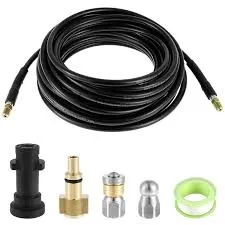power steering hose replacement instructions
Power Steering Hose Replacement Instructions
Replacing the power steering hose is an essential maintenance task that ensures the smooth operation of your vehicle’s steering system. The power steering system relies on hydraulic fluid, and any leaks in the system can lead to a loss of steering control. If you notice any signs of wear, such as fluid leaks or difficulty steering, it may be time to replace your power steering hose. This article provides step-by-step instructions to help you successfully replace the power steering hose in your vehicle.
Tools and Materials Needed
Before beginning the replacement, gather the following tools and materials - New power steering hose - Socket wrench set - Screwdriver set - Pliers - Fluid catch pan - Towels or rags - Power steering fluid - Safety glasses - Gloves
Step 1 Prepare the Vehicle
Start by parking your vehicle on a level surface and engaging the parking brake. Allow the engine to cool if it has been running. For added safety, disconnect the negative battery terminal to prevent any electrical issues while you work.
Step 2 Locate the Power Steering Hose
Open the hood and locate the power steering reservoir. The power steering hose runs from the reservoir to the steering gear. Depending on your vehicle's make and model, you may need to consult the owner's manual or a repair guide to find the exact routing of the hose.
Step 3 Drain the Power Steering Fluid
Place a fluid catch pan under the power steering system to catch any spilled fluid. Loosen the reservoir cap to relieve pressure, then use a turkey baster or similar tool to siphon out the fluid from the reservoir. Make sure to dispose of the old fluid properly according to local regulations.
power steering hose replacement instructions

Step 4 Disconnect the Old Hose
Using the appropriate socket or wrench, carefully loosen the clamps or fittings securing the old power steering hose. Be cautious as any remaining fluid may spill out. Once you’ve removed the hose from both the reservoir and the steering gear, inspect the fittings for wear and damage.
Step 5 Install the New Hose
Take your new power steering hose and connect it to the steering gear first. Tighten the fittings securely but avoid overtightening, as this can damage the hose or the fittings. Next, connect the other end of the hose to the power steering reservoir, again ensuring a snug fit.
Step 6 Refill the Power Steering Fluid
After successfully installing the new hose, pour new power steering fluid into the reservoir until it reaches the recommended level. Consult your owner’s manual for the correct type of fluid to use.
Step 7 Check for Leaks and Test the System
Reconnect the negative battery terminal and start your vehicle. Allow the engine to run for a few minutes while turning the steering wheel left and right to circulate the fluid. Check the new hose and surrounding areas for any leaks. If everything looks good, close the hood and take your vehicle for a short test drive to ensure proper functionality.
Conclusion
Replacing your power steering hose is a straightforward process that can save you from more significant steering problems in the future. By following these steps and ensuring your system is free of leaks, you can maintain the smooth operation of your vehicle’s steering. Always remember to dispose of old fluids responsibly and wear protective gear when working on your vehicle.
-
Understanding Power Steering Tube ReplacementNewsApr.16,2025
-
SAE J1401 Brake Hoses: A Critical Component for Vehicle SafetyNewsApr.16,2025
-
Pipe Couplings: Essential Components for Effective Plumbing and Fluid SystemsNewsApr.16,2025
-
Hose Guard Solutions for Every NeedNewsApr.16,2025
-
Effective Spiral Protection SolutionsNewsApr.16,2025
-
Effective Sewer Cleaning SolutionsNewsApr.16,2025

